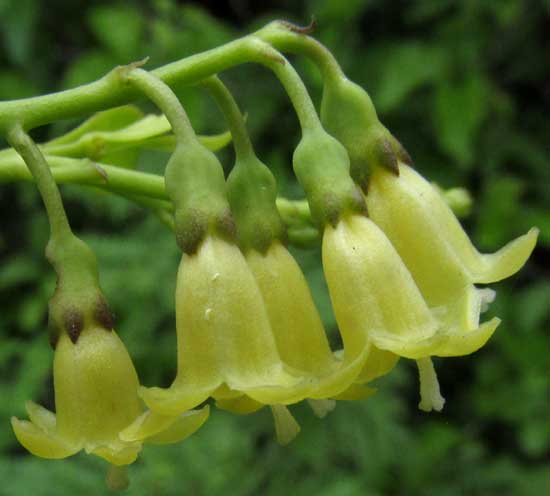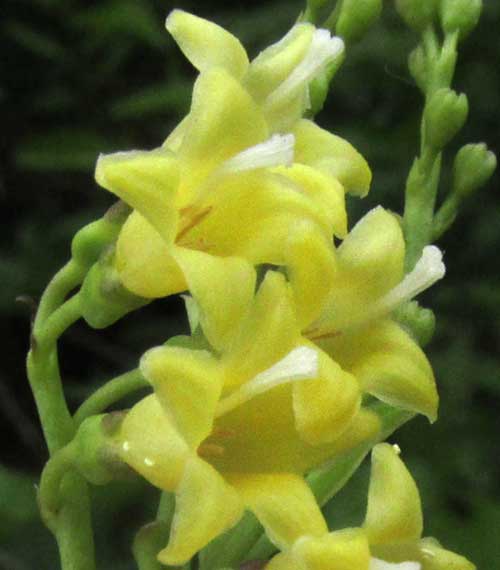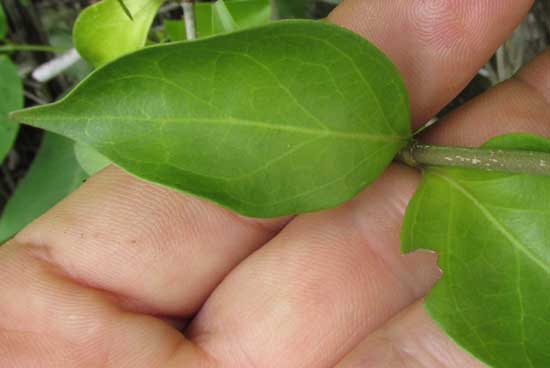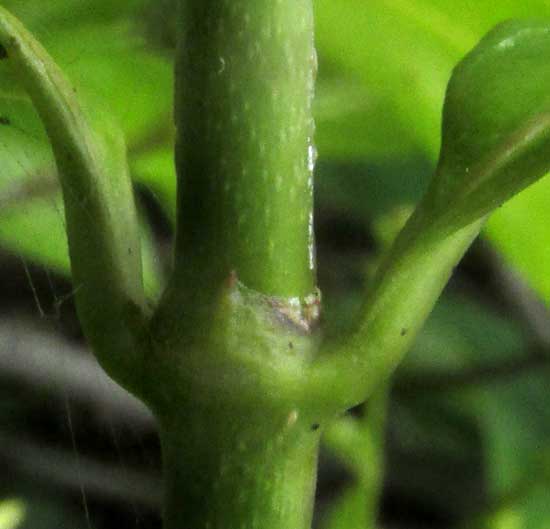Excerpts from Jim Conrad's
Naturalist Newsletter
from the June 25, 2017 Newsletter issued from Rancho Regensis north of Valladolid, Yucatán, MÉXICO;
elevation ~40m (~130 ft), N~20.876°, W~88.170°
SNOWBERRY FLOWERING
Along the Caribbean coast we've found many Snowberry shrubs abundantly producing pea-sized fruits, the fruits looking like little white eyeballs with small dark pupils, as shown at the bottom of this page. Though common along the coast I've rarely found Snowberries here in the more arid interior, on thin, limestone soil. That's one reason I wasn't sure what I had when last Sunday along the highway a much-branching, chest-high shrub turned up enmeshed in a roadside thicket, with loads of small, yellowish-white, bell-shaped flowers attractively dangling face-down from panicle branches, as seen below:

A close-up of some of the neat little blossoms is shown below:

In that picture one feature to notice is that the calyx''s sepals appear to arise above the ovaries, so the flowers must have " inferior ovaries." Most flowers have superior ovaries, so if these really are inferior that could help a lot in identifying the species. Removing the corolla, it's easier to see that the ovary really is inferior, as seen below:

Below, you can see that the flowers' white styles are 2-lobed at their tips, and that the few stamens huddle down in the corolla tubes

The shrub's leaves arose opposite one another on the stems -- on most plants they're alternate -- so this is another good field mark. You can see the opposite leaves below:

In the American tropics any woody plant with opposite leaves and producing inferior ovaries very often, but certainly not always, is a member of the big Coffee or Madder Family, the Rubiaceae. To confirm that you have a "Rube," look for conspicuous stipules on the stems, connecting the tops of the opposite leaves' petioles. They might look something like the ones shown on our roadside plant, seen below:

Once it was clear that our roadside bush was a Rube, finally it dawned on me that this must be a flowering Snowberry. Before now I've only noticed fruiting plants.
Henriette's Herbal Homepage, featuring home-remedy information from the 1898 publication King's American Dispensatory, tells us in an outdated kind of stiff but subjunctive-wise English that "In medium doses it augments the urinary discharge, slightly accelerates the action of the heart, and increases the peristaltic action of the bowels; and if the body be kept warm, and warm infusions be drank, instead of purging it will produce perspiration. In large doses it produces the most violent emetic and drastic effects."
It further says that the plant's use is indicated when there's "Scanty urine with a sense of fullness in the loins; edematous feet and eyelids."
You can read Henriette's entire page on Snowberry -- there referred to as Cahinca -- at http://www.henriettes-herb.com/eclectic/kings/chiococca.html

from the September 4, 2011 Newsletter issued from Mayan Beach Garden Inn 20 kms north of Mahahual; Caribbean coastal beach and mangroves, ~N18.89°, ~W87.64°, Quintana Roo state, MÉXICO
SNOWBERRY
Lots of plants bearing white fruits are called snowberries. One of those, a shrub usually about eight feet tall (2.5m) is prettily fruiting along our roads nowadays, with white, pea-sized berries, as shown above. A close-up of some of the black-eyed fruits appears below:

This dense bush with slender, brittle stems and opposite leaves (two leaves at each stem node) occurs from Florida and Texas's Lower Rio Grande Valley through Mexico and the Caribbean into South America. Occurring in several English-speaking countries, it goes by other English names than Snowberry, such as Milkberry, West Indian Snowberry, David's Milkberry and Davis Root. It's CHIOCOCCA ALBA, a member of the same family as Coffee and gardenias, the Rubiaceae.
That name "Davis Root" points to a time when Snowberry's roots were used medicinally, as a laxative, diuretic, emetic, and against diarrhea. Years ago the plant was sold commercially as a medicinal plant in Europe and the US.
Snowberry is one of those bushes that acts like it wants to be a vine; it leans onto and grows over other shrubs and trees. Some gardeners espalier it or train it to trellises.